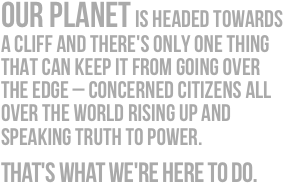by Joe Perullo
I decided to do some investigating on who exactly the country delegates were. Who hires them? Who are they really representing? What do they do outside of the UNFCCC? When we say the US is stalling progress and shoving responsibility onto developing countries, who exactly do we mean? A lot of fingers are pointed at the delegates, but they’re just people, right?
The US was my case study, but I’m sure the basic structure (not to be confused with political agenda) can be applied to most countries.
As we know, the countries’ positions are determined long before the negotiations take place by foreign ministers. In the US, this responsibility is given to the State Department, a department under the Executive branch (so the president has the ultimate authority). The delegates we see negotiating at COP are usually workers of the state department or people hired by it. Within the State Department, policies pertaining to the COP are done by the Bureau of Oceans and International Environmental and Scientific Affairs (OES). This is where they lay out exactly what they want the text to look like coming out of a COP. Now, I’m sure they really do care about the environment, but keep in mind that any standpoints they want the delegates to make at COP need to get approval by the greater Department of State—who’s agenda isn’t confined to making international peace or saving the planet but to bettering the lives of Americans—and be signed by the Secretary of State, who is nominated by the president and confirmed by the Senate.
The State Department’s official agenda is, as officially mentioned in the Foreign Policy Agenda, “to create a more secure, democratic, and prosperous world for the benefit of the American people and the international community.” In reality consideration of the international community is far from the top of the list. The “american exceptionalism” of the country and its governments will not allow members of the house, who also need to think about re-elections, pass a bill that would let the country fall behind China in the green economy. And lets not forget about corporate lobbyist. Even if the OES and the delegates want nothing more than for the US to reduce emissions, they are at the whims of the State Department.
This is exactly what happened with the Kyoto Protocol—the US signed on to it but it could not be ratified through congress. That signing was a clear “mistake” on behalf of the US COP delegates who negotiated such a protocol out, since it did not accurately reflect the actual will of the US to have legally binding emission reduction targets. With this system, the delegates in some way “weren’t” doing their job. I wouldn’t be surprised if they were released or given undesirable positions as punishment.
This gives American political environmentalists a tough choice: do they focus their energy in the international realm, where they can more tangibly deal with policies that affect the world, or in their own country, in an attempt to influence the internal struggles that determine when the true gavel is smashed in international negotiations?


